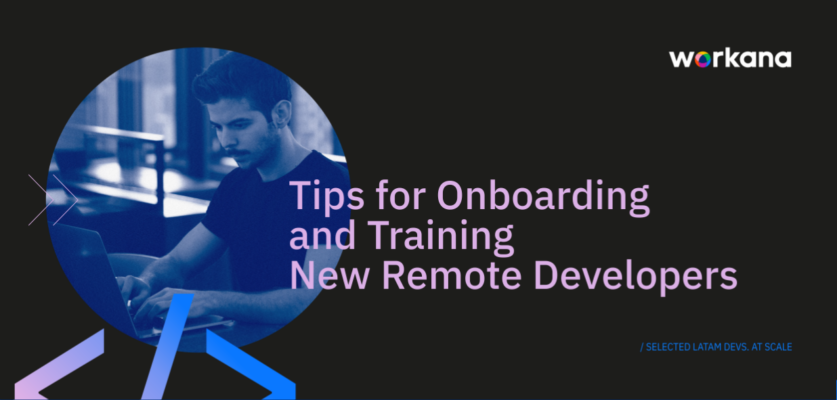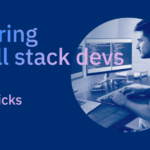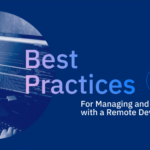At Workana, we use a rigorous selection process for recruiting devs in Latin America, but we know that the work doesn’t end after you pick your ideal candidate. After the match, there’s still onboarding which is a fundamental step for accelerating the candidate’s transition into the job and sets both parties’ expectations.
Companies that invest in good onboarding processes see new hires’ productivity nearly double. On the other hand, it’s no secret that it’s really hard to retain an employee who had a bad experience at the beginning of the working relationship.
Why is it Important to Use a Good Onboarding Process With Your Devs?
Whether you run a company with a hybrid work model or a 100% remote startup, it’s important to have a comprehensive, well-structured onboarding process. The right onboarding allows you to:
- Speed up the learning curve
- Decrease errors that cost time and money
- Improve internal communication
- Accelerate how long it takes for a hire to fully integrate with the team
- Establish performance expectations
- Prevent friction within the company culture
- Decrease new hires’ stress levels and turnover rates
What Are the Most Common Problems Encountered During the 100% Remote Onboarding Process?
Up to 15% of new tech hires end up quitting due to issues that came up during the onboarding stage.
According to a study conducted with more than 200 remote developers hired by Microsoft, 100% remote onboarding can be a lot more challenging. This is mostly because it can be more difficult to interact with coworkers and understand the company’s unspoken rules, but it can also be due to availability issues for certain types of hardware and software.
In fact, a 2019 survey found that 63% of remote developers who responded felt that the onboarding processes used by the companies where they worked left a lot to be desired. Unlike what some might have expected during the pandemic at the peak of mass migration to working from home, in 2021 just 21% of remote team members felt like they were off to a good start with their employers.
Plus, nearly half of the devs surveyed reported that they didn’t feel connected to the rest of the team after one month of being in their new position. This was, in large part, due to the company’s lack of interest in creating team building opportunities for them.
Seven Good Practices for Dev Onboarding and Training
According GitLab, a full onboarding process for a developer should take two to three weeks. However, the team member can start integrating into their role at the same time little by little without being expected to perform at 100% from day one.
Onboarding should cover the technical, company, and social aspects of the job. In other words, how is the work done, how do people communicate, and how people relate to each other within the company. Here’s a list of good practices that will help you make sure that your onboarding process has everything covered.
1.- Create Visual Manuals
Investing time into creating a well-written onboarding manual is one of the best things you can do to streamline the onboarding process. This manual can be a Word document or even an interactive video with quizzes.
What’s most important is that everything is standardized from the start and designed to be as clear and specific as possible for future team members. Opting for videos and prioritizing visual communication with screenshots and examples over endless written instructions is key.
2.- Keep Everything in One Place and Foster Test Environments
One of the biggest headaches for new team members, especially if they’re remote, is when the information they need is spread across a lot of different channels that they aren’t familiar with or maybe is even stored in files that aren’t relevant to their jobs.
The first thing you’ll need to do is decide what the “main point of entry” will be. This point of entry will be where the devs can find everything they need. Depending on the tools you have available, you can put all the information into one folder in the cloud and give a team member access to it, or you can create something more elaborate with an LMS.
While it isn’t always possible, ideally you’ll want to create a testing environment so the developer can get right to work without running the risk of disrupting the team’s flow without needing to micromanage. It’s much better to let someone make a lot of headway on their own and then offer feedback during the same onboarding period.
This way, you’ll also significantly decrease stress that devs can feel from potential errors and day-to-day deadlines.
3.- Create a Checklist
A checklist will help you find out if your employees have already finished their onboarding activities, and it’ll help team members understand the overall role of onboarding. In other words, they’ll have familiarized themselves with all the aspects that they need to know about. Some of these aspects are:
- Theory and practice: for example, reviewing the code’s style manual and running a test on it.
- Understanding different workflows and being able to answer questions like ‘what are our next steps after finishing a sprint?’
- Having a list of people for answering questions about different subjects.
- Meet all the cybersecurity requirements.
- Confirm that everyone is using the hardware and software correctly.
- Review the collaborative document of FAQs.
- Read the internal communication manual and codes of conduct
4.- Don’t Forget About Company Culture
During the onboarding process, expectations should be clearly set in terms of codes of conduct, what types of feedback are allowed and which ones aren’t, the general values that guide what everyone does, etc.
Company culture also involves aspects like when to establish communication and send deliverables, examples of how to resolve disputes and interpersonal conflict, and how much availability team members have during crises or unexpected events.
5.- Assign Each New Team Member a Mentor
Your new dev’s mentor can be just another dev who works in the same position but has a little more experience on the team.
It’s important that the peer mentoring is done voluntarily. In other words, every time you bring on a new team member, ask your team who would like to help the newcomer during their onboarding process.
6.- Create a Collaborative Document With FAQ´s
One of the worst and most widespread practices in every company is to establish methods or solve problems without putting everything in writing into a document that’s accessible and available to all the team members.
In addition to being extremely useful for onboarding, creating a collaborative document with FAQs and updating it on a regular basis is a great way to concentrate key information and streamline processes.
Keep in mind that a lot of newcomer questions can be answered faster if they have access to a document with past knowledge and information from coworkers who have faced and overcome the same challenges.
7.- Get to Know Your Talent
After welcoming all the team members, you’ll want to take the time to get to know every team member and understand their work background, their preferred work style, and what kind of situations can help or hinder good performance.
It’s also important to get comfortable with viewing the onboarding process as more than just answering questions. Onboarding is also about asking questions like if someone prefers a more guided or hands-off leadership style and how a new hire works on a day-to-day basis.
Remember, good onboarding is just as important and good recruitment. Not all devs will start out being the perfect fit with your company culture, so we recommend supplementing the welcome plan with a good hiring tool.
At Workana, we can find the perfect dev with all the skills you’re looking for, or we even build an entire developer dream team for your project. Best of all, we offer a seven day risk-free trial so you can assess their work and take the time to decide if you’d like to move forward with them.
You may also be interested in:
- The Advantages of Employing Cross-Border Hiring for Your Startup or Company
- Finding and Hiring Most Talented Devs IS Possible: Latin America is the Solution
- How to Screen and Interview Remote Developer Candidates Effectively
- Pro Tips For Managing Remote IT Talent Teams
- 5 Benefits of Using a Talent Consulting Firm









